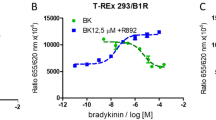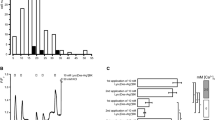Summary
We have examined the activation of a phospholipase C signal transduction pathway by a B2-bradykinin receptor in the human astrocytoma cell line D384 and how this influences D1-dopamine receptor stimulated cyclic AMP accumulation. Addition of bradykinin to D384 cells resulted in a concentration-dependent (10−11 − 10−6 M) increase in the accumulation of [3H]inositol phosphates and a similar concentration-dependent transient increase in specific [3H]β-phorbol-12,13-dibutyrate binding which is indicative of translocation of protein kinase C from the cytosol to the membrane. Changes in intracellular Ca2+ of single cells, measured using the fluorescent indicator dye fura-2, indicated that bradykinin produced a rapid, but transient, increase in intracellular calcium. The Ca2+ response was largely independent of extracellular Ca2+ supporting the idea that receptor activation leads to mobilization of Ca2+ from intracellular stores. However, extracellular Ca2+ was required for a response to a rechallenge with bradykinin. The bradykinin B2-receptor agonist kallidin increased cytosolic Ca 2+ in a similar manner to bradykinin. The Ca2+ response to bradykinin could be partially reduced in the presence of the B2-receptor antagonist [d-Arg10-Hyp,d-Phe7,β-(2-Thienyl)-Ala5,8]-bradykinin, whereas the B1-receptor agonists (Des-Arg9]-bradykinin and [Des-Arg10]-kallidin were ineffective. Bradykinin was also found to attenuate dopamine stimulated cyclic AMP accumulation in D384 cells, at similar concentrations previously observed to stimulate the phospholipase C signal transduction pathway, in the presence of the phosphodiesterase inhibitor, rolipram. In contrast, no attenuation was observed in the presence of the phosphodiesterase inhibitor 1-isobutyl 3-methylxanthine, although the level of dopamine stimulated cyclic AMP observed was lower than in the presence of rolipram. Furthermore, the effect of bradykinin could be mimicked by a calcium ionophore, but not a phorbol ester. These data suggest that D384 cells express a B2 bradykinin receptor coupled to polyphosphoinositide-specific phospholipase C. Activation of this receptor results in elevated levels of cytosolic Ca2+ and to a reduction of D1-dopamine receptor stimulated cyclic AMP accumulation.
Similar content being viewed by others

References
Altiok N, Balmforth AJ, Fredholm BB (1992) Adenosine receptor-induced cAMP changes in D384 astrocytoma cells and the effect of bradykinin thereon. Acta Physiol Scand 144:55–63
Altiok N, Fredholm BB (1992) Bradykinin inhibition of cyclic AMP accumulation in D384 astrocytoma cells. Evidence against a role of cyclic GMP. Neurochem Int (in press)
Balmforth AJ, Yasunari K, Vaughan PFT, Ball SG (1988) Characterization of dopamine and β-adrenergic receptors linked to cyclic AMP formation in intact cells of the clone D384 derived from a human astrocytoma. J Neurochem 51:1510–1515
Beavo JA (1988) Multiple isozymes of cyclic nucleotide phosphodiesterase. In: Brooker G, Greengard P, Robison GA (eds) Adv. in Second Messenger and Phosphoprotein Res, vol 10. Raven Press, New York, pp 1–38
Berridge MJ, Irvine RF (1989) Inositol phosphates and cell signalling. Nature 341:197–205
Boulanger C, Schini VB, Moncada S, Vanhoutte PM (1990) Stimulation of cyclic GMP production in cultured endothelial cells of the pig by bradykinin, adenosine diphosphate, calcium ionophore A23187 and nitric oxide. Br J Pharmacol 101:152–156
Cohen CS, Connor JA, Kater SB (1987) Electrically and chemically mediated increases in intracellular calcium in neuronal growth cones. J Neurosci 7:3588–3599
Darbon JM, Oury F, Clamens S, Bayard F (1987) TPA induces subcellular translocation and subsequent down-regulation of both phorbol ester binding and protein kinase C activities in MCF-7 cells. Biochem Biophys Res Commun 146:537–546
Davis CW (1984) Assessment of selective inhibition of rat cerebral cortical calcium-independent and calcium-dependent phospho-diesterases in crude extracts using deoxycyclic AMP and potassium ions. Biochim Biophys Acta 797:354–362
Dixon BS, Breckon R, Fortune J, Sutherland E, Simon FR, Anderson RJ (1989) Bradykinin activates protein kinase C in cultured cortical collecting tubular cells. Am J Physiol 257: F808-F817
Dubyak GR, Cohen DS, Meuller LM (1988) Activation of inositol phospholipid breakdown in HL60 cells by P2-purinergic receptors for extracellular ATP. J Biol Chem 263:18108–18117
Grynkiewicz G, Poenie M, Tsien RY (1985) A new generation of Ca2+ indicators with greatly improved fluorescence properties. J Biol Chem 260:3440–3450
Hepler JR, Hughes R, Harden TK (1987) Evidence that muscarinic cholinergic receptors selectively interact with either the cyclic AMP or the inositol phosphate second messenger response systems. Biochem J 247:793–796
Kraft AS, Anderson WB (1983) Phorbol esters increase the amount of Ca2+, phospholipid-dependent protein kinase C associated with plasma membrane. Nature 301: 621–623
Kremer S, Harper P, Hegele R, Skorecki K (1988) Bradykinin stimulates a rise in cytosolic calcium in renal glomerular mesangial cells via a pertussis toxin insensitive pathway. Can J Physiol Pharmacol 66:43–48
May WS Jr, Sahyoun N, Wolf M, Cuatrecasas P (1985) Role of intracellular calcium mobilization in the regulation of protein kinase-C mediated membrane processes. Nature 317:549–551
Meeker RB, Harden TK (1982) Muscarinic cholinergic receptor-mediated activation of phosphodiesterase. Mol Pharmacol 22:310–319
Nemoz G, Prigent AF, Moueqqit M, Fougier S, Macovschi O, Pacheco H (1985) Selective inhibition of one of the cyclic AMP phosphodiesterases from rat brain by the neurotropic compound rolipram. Biochem Pharmacol 34:2997–3000
Nishizuka Y (1984) The role of protein kinase C in cell surface signal transduction and tumor promotion. Nature 308:693–698
Osugi T, Uchida S, Imaizumi T, Yoshida H (1986) Bradykinin-induced intracellular Ca2+ elevations in neuroblastoma × glioma hybrid NG108–15 cells; relationship to the action of inositol phospholipids metabolites. Brain Res 397:84–89
Regoli D, Rhaleb NE, Dion S, Drapeau G (1990) New selective bradykinin receptor antagonists and bradykinin B2 receptor characterization. Trends Pharmacol Sci 11:156–161
Reiser G, Binmoller FJ, Donie F (1990) Mechanisms for activation and subsequent removal of cytosolic Ca2+ in bradykinin-stimulated neuronal and glial cell lines. Exp Cell Res 186:47–53
Salomon Y, Londos C, Rodbell M (1974) A highly sensitive adenylate cyclase assay. Anal Biochem 58: 541–548
Schutze S, Nottrott S, Pfizenmaier K, Kronke M (1990) Tumor necrosis factor signal transduction; cell-type-specific activation and translocation of protein kinase C. J Immunol 144:2604–2608
Shimizu H, Daly JW, Creveling CR (1969) A radioisotopic method for measuring the formation of adenosine 3′,5′-cyclic monophosphate in incubated slices of brain. J Neurochem 16:1609–1619
Tanner LI, Harden TK, Wells JN, Martin MW (1986) Identification of the phosphodiesterase regulated by muscarinic cholinergic receptors of 1321N1 human astrocytoma cells. Mol Pharmacol 29:455–460
Trilivas I, Brown JH (1989) Increases in intracellular Ca2+ regulate the binding of [3H]-phorbol 12,13-dibutyrate to intact 1321N1 astrocytoma cells. J Biol Chem 246:3102–3107
Whalin ME, Scammell JG, Strada SJ, Thompson WJ (1991) Phosphodiesterase II, the cGMP-activatable cyclic nucleotide phosphodiesterase, regulates cyclic AMP metabolism in PC12 cells. Mol Pharmacol 39: 711–717
Author information
Authors and Affiliations
Additional information
Correspondence to A. J. Balmforth at the above address
Rights and permissions
About this article
Cite this article
Balmforth, A.J., Parkinson, F.E., Altiok, N. et al. Identification of a B2-bradykinin receptor linked to phospholipase C and inhibition of dopamine stimulated cyclic AMP accumulation in the human astrocytoma cell line D384. Naunyn-Schmiedeberg's Arch Pharmacol 346, 303–310 (1992). https://doi.org/10.1007/BF00173543
Received:
Accepted:
Issue Date:
DOI: https://doi.org/10.1007/BF00173543



